Di Niu
FP4DiT: Towards Effective Floating Point Quantization for Diffusion Transformers
Mar 19, 2025Abstract:Diffusion Models (DM) have revolutionized the text-to-image visual generation process. However, the large computational cost and model footprint of DMs hinders practical deployment, especially on edge devices. Post-training quantization (PTQ) is a lightweight method to alleviate these burdens without the need for training or fine-tuning. While recent DM PTQ methods achieve W4A8 on integer-based PTQ, two key limitations remain: First, while most existing DM PTQ methods evaluate on classical DMs like Stable Diffusion XL, 1.5 or earlier, which use convolutional U-Nets, newer Diffusion Transformer (DiT) models like the PixArt series, Hunyuan and others adopt fundamentally different transformer backbones to achieve superior image synthesis. Second, integer (INT) quantization is prevailing in DM PTQ but doesn't align well with the network weight and activation distribution, while Floating-Point Quantization (FPQ) is still under-investigated, yet it holds the potential to better align the weight and activation distributions in low-bit settings for DiT. In response, we introduce FP4DiT, a PTQ method that leverages FPQ to achieve W4A6 quantization. Specifically, we extend and generalize the Adaptive Rounding PTQ technique to adequately calibrate weight quantization for FPQ and demonstrate that DiT activations depend on input patch data, necessitating robust online activation quantization techniques. Experimental results demonstrate that FP4DiT outperforms integer-based PTQ at W4A6 and W4A8 precision and generates convincing visual content on PixArt-$\alpha$, PixArt-$\Sigma$ and Hunyuan in terms of several T2I metrics such as HPSv2 and CLIP.
TreeX: Generating Global Graphical GNN Explanations via Critical Subtree Extraction
Mar 12, 2025Abstract:The growing demand for transparency and interpretability in critical domains has driven increased interests in comprehending the explainability of Message-Passing (MP) Graph Neural Networks (GNNs). Although substantial research efforts have been made to generate explanations for individual graph instances, identifying global explaining concepts for a GNN still poses great challenges, especially when concepts are desired in a graphical form on the dataset level. While most prior works treat GNNs as black boxes, in this paper, we propose to unbox GNNs by analyzing and extracting critical subtrees incurred by the inner workings of message passing, which correspond to critical subgraphs in the datasets. By aggregating subtrees in an embedding space with an efficient algorithm, which does not require complex subgraph matching or search, we can make intuitive graphical explanations for Message-Passing GNNs on local, class and global levels. We empirically show that our proposed approach not only generates clean subgraph concepts on a dataset level in contrast to existing global explaining methods which generate non-graphical rules (e.g., language or embeddings) as explanations, but it is also capable of providing explanations for individual instances with a comparable or even superior performance as compared to leading local-level GNN explainers.
Applying Graph Explanation to Operator Fusion
Dec 31, 2024



Abstract:Layer fusion techniques are critical to improving the inference efficiency of deep neural networks (DNN) for deployment. Fusion aims to lower inference costs by reducing data transactions between an accelerator's on-chip buffer and DRAM. This is accomplished by grouped execution of multiple operations like convolution and activations together into single execution units - fusion groups. However, on-chip buffer capacity limits fusion group size and optimizing fusion on whole DNNs requires partitioning into multiple fusion groups. Finding the optimal groups is a complex problem where the presence of invalid solutions hampers traditional search algorithms and demands robust approaches. In this paper we incorporate Explainable AI, specifically Graph Explanation Techniques (GET), into layer fusion. Given an invalid fusion group, we identify the operations most responsible for group invalidity, then use this knowledge to recursively split the original fusion group via a greedy tree-based algorithm to minimize DRAM access. We pair our scheme with common algorithms and optimize DNNs on two types of layer fusion: Line-Buffer Depth First (LBDF) and Branch Requirement Reduction (BRR). Experiments demonstrate the efficacy of our scheme on several popular and classical convolutional neural networks like ResNets and MobileNets. Our scheme achieves over 20% DRAM Access reduction on EfficientNet-B3.
Qua$^2$SeDiMo: Quantifiable Quantization Sensitivity of Diffusion Models
Dec 19, 2024


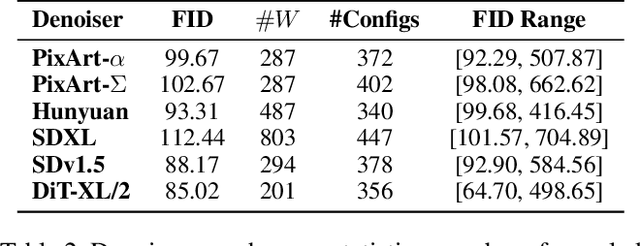
Abstract:Diffusion Models (DM) have democratized AI image generation through an iterative denoising process. Quantization is a major technique to alleviate the inference cost and reduce the size of DM denoiser networks. However, as denoisers evolve from variants of convolutional U-Nets toward newer Transformer architectures, it is of growing importance to understand the quantization sensitivity of different weight layers, operations and architecture types to performance. In this work, we address this challenge with Qua$^2$SeDiMo, a mixed-precision Post-Training Quantization framework that generates explainable insights on the cost-effectiveness of various model weight quantization methods for different denoiser operation types and block structures. We leverage these insights to make high-quality mixed-precision quantization decisions for a myriad of diffusion models ranging from foundational U-Nets to state-of-the-art Transformers. As a result, Qua$^2$SeDiMo can construct 3.4-bit, 3.9-bit, 3.65-bit and 3.7-bit weight quantization on PixArt-${\alpha}$, PixArt-${\Sigma}$, Hunyuan-DiT and SDXL, respectively. We further pair our weight-quantization configurations with 6-bit activation quantization and outperform existing approaches in terms of quantitative metrics and generative image quality.
PixelMan: Consistent Object Editing with Diffusion Models via Pixel Manipulation and Generation
Dec 18, 2024



Abstract:Recent research explores the potential of Diffusion Models (DMs) for consistent object editing, which aims to modify object position, size, and composition, etc., while preserving the consistency of objects and background without changing their texture and attributes. Current inference-time methods often rely on DDIM inversion, which inherently compromises efficiency and the achievable consistency of edited images. Recent methods also utilize energy guidance which iteratively updates the predicted noise and can drive the latents away from the original image, resulting in distortions. In this paper, we propose PixelMan, an inversion-free and training-free method for achieving consistent object editing via Pixel Manipulation and generation, where we directly create a duplicate copy of the source object at target location in the pixel space, and introduce an efficient sampling approach to iteratively harmonize the manipulated object into the target location and inpaint its original location, while ensuring image consistency by anchoring the edited image to be generated to the pixel-manipulated image as well as by introducing various consistency-preserving optimization techniques during inference. Experimental evaluations based on benchmark datasets as well as extensive visual comparisons show that in as few as 16 inference steps, PixelMan outperforms a range of state-of-the-art training-based and training-free methods (usually requiring 50 steps) on multiple consistent object editing tasks.
MAS-Attention: Memory-Aware Stream Processing for Attention Acceleration on Resource-Constrained Edge Devices
Nov 20, 2024Abstract:The advent of foundation models have revolutionized various fields, enabling unprecedented task accuracy and flexibility in computational linguistics, computer vision and other domains. Attention mechanism has become an essential component of foundation models, due to their superb capability of capturing correlations in a sequence. However, attention results in quadratic complexity in memory and compute as the context length grows. Although many fusion-based exact attention acceleration algorithms have been developed for datacenter-grade GPUs and accelerators leveraging multi-core parallelism and data locality, yet it remains a significant challenge to accelerate attention on resource-constrained edge neural accelerators with limited compute units and stringent on-chip caches. In this paper, we propose a scheme for exact attention inference acceleration on memory-constrained edge accelerators, by parallelizing the utilization of heterogeneous compute units, i.e., vector processing units and matrix processing units. Our method involves scheduling workloads onto these different compute units in a multi-tiered tiling scheme to process tiled vector workloads and matrix workloads in attention as two streams, respecting the workload dependencies. We search for tiling factors to maximize the parallelization of both compute units while considering I/O overhead, and propose a proactive cache overwrite strategy to avoid undesirable cache spills in reality. Extensive results based on open-sourced simulation frameworks show up to 2.75x speedup and 54% reduction in energy consumption as compared to the state-of-the-art attention fusion method (FLAT) in the edge computing scenario. Further experiments on a real-world edge neural processing unit demonstrate speedup of up to 1.76x for attention as compared to FLAT, without affecting model output accuracy.
Learning Truncated Causal History Model for Video Restoration
Oct 15, 2024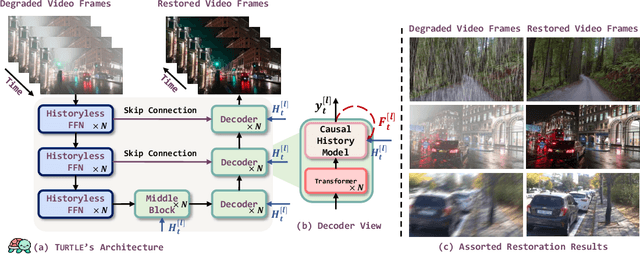
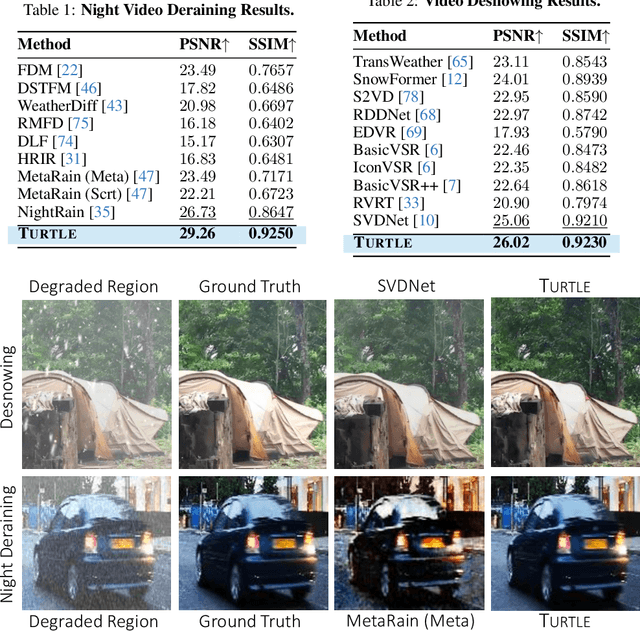

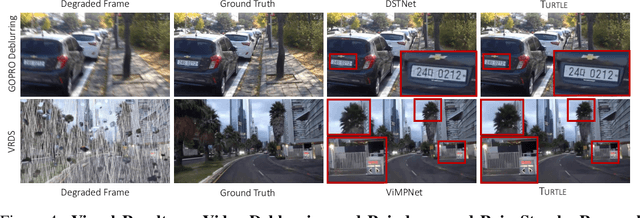
Abstract:One key challenge to video restoration is to model the transition dynamics of video frames governed by motion. In this work, we propose TURTLE to learn the truncated causal history model for efficient and high-performing video restoration. Unlike traditional methods that process a range of contextual frames in parallel, TURTLE enhances efficiency by storing and summarizing a truncated history of the input frame latent representation into an evolving historical state. This is achieved through a sophisticated similarity-based retrieval mechanism that implicitly accounts for inter-frame motion and alignment. The causal design in TURTLE enables recurrence in inference through state-memorized historical features while allowing parallel training by sampling truncated video clips. We report new state-of-the-art results on a multitude of video restoration benchmark tasks, including video desnowing, nighttime video deraining, video raindrops and rain streak removal, video super-resolution, real-world and synthetic video deblurring, and blind video denoising while reducing the computational cost compared to existing best contextual methods on all these tasks.
FRAP: Faithful and Realistic Text-to-Image Generation with Adaptive Prompt Weighting
Aug 21, 2024



Abstract:Text-to-image (T2I) diffusion models have demonstrated impressive capabilities in generating high-quality images given a text prompt. However, ensuring the prompt-image alignment remains a considerable challenge, i.e., generating images that faithfully align with the prompt's semantics. Recent works attempt to improve the faithfulness by optimizing the latent code, which potentially could cause the latent code to go out-of-distribution and thus produce unrealistic images. In this paper, we propose FRAP, a simple, yet effective approach based on adaptively adjusting the per-token prompt weights to improve prompt-image alignment and authenticity of the generated images. We design an online algorithm to adaptively update each token's weight coefficient, which is achieved by minimizing a unified objective function that encourages object presence and the binding of object-modifier pairs. Through extensive evaluations, we show FRAP generates images with significantly higher prompt-image alignment to prompts from complex datasets, while having a lower average latency compared to recent latent code optimization methods, e.g., 4 seconds faster than D&B on the COCO-Subject dataset. Furthermore, through visual comparisons and evaluation on the CLIP-IQA-Real metric, we show that FRAP not only improves prompt-image alignment but also generates more authentic images with realistic appearances. We also explore combining FRAP with prompt rewriting LLM to recover their degraded prompt-image alignment, where we observe improvements in both prompt-image alignment and image quality.
Achieving Complex Image Edits via Function Aggregation with Diffusion Models
Aug 16, 2024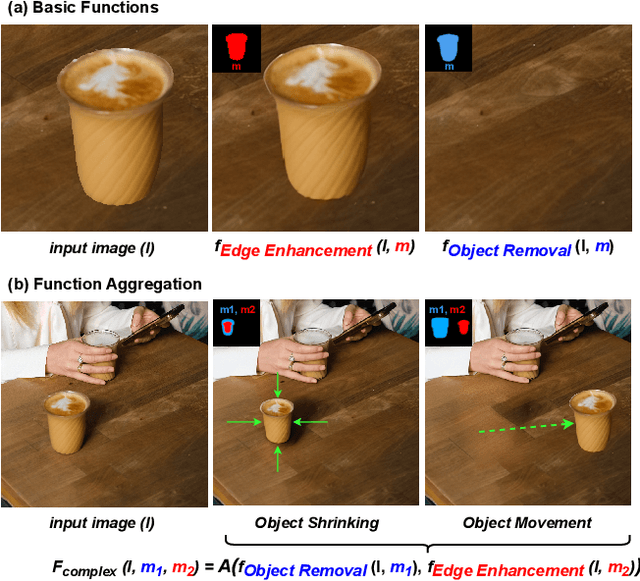
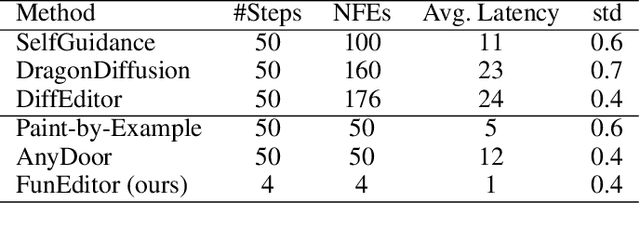
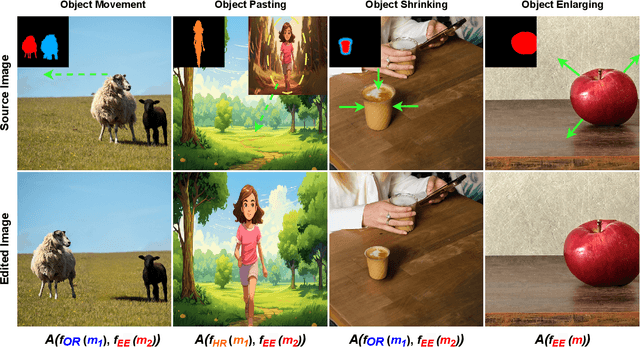

Abstract:Diffusion models have demonstrated strong performance in generative tasks, making them ideal candidates for image editing. Recent studies highlight their ability to apply desired edits effectively by following textual instructions, yet two key challenges persist. First, these models struggle to apply multiple edits simultaneously, resulting in computational inefficiencies due to their reliance on sequential processing. Second, relying on textual prompts to determine the editing region can lead to unintended alterations in other parts of the image. In this work, we introduce FunEditor, an efficient diffusion model designed to learn atomic editing functions and perform complex edits by aggregating simpler functions. This approach enables complex editing tasks, such as object movement, by aggregating multiple functions and applying them simultaneously to specific areas. FunEditor is 5 to 24 times faster inference than existing methods on complex tasks like object movement. Our experiments demonstrate that FunEditor significantly outperforms recent baselines, including both inference-time optimization methods and fine-tuned models, across various metrics, such as image quality assessment (IQA) and object-background consistency.
Optimizing and Testing Instruction-Following: Analyzing the Impact of Fine-Grained Instruction Variants on instruction-tuned LLMs
Jun 17, 2024Abstract:The effective alignment of Large Language Models (LLMs) with precise instructions is essential for their application in diverse real-world scenarios. Current methods focus on enhancing the diversity and complexity of training and evaluation samples, yet they fall short in accurately assessing LLMs' ability to follow similar instruction variants. We introduce an effective data augmentation technique that decomposes complex instructions into simpler sub-components, modifies these, and reconstructs them into new variants, thereby preserves the original instruction's context and complexity while introducing variability, which is critical for training and evaluating LLMs' instruction-following precision. We developed the DeMoRecon dataset using this method to both fine-tune and evaluate LLMs. Our findings show that LLMs fine-tuned with DeMoRecon will gain significant performance boost on both ours and commonly used instructions-following benchmarks.
 Add to Chrome
Add to Chrome Add to Firefox
Add to Firefox Add to Edge
Add to Edge